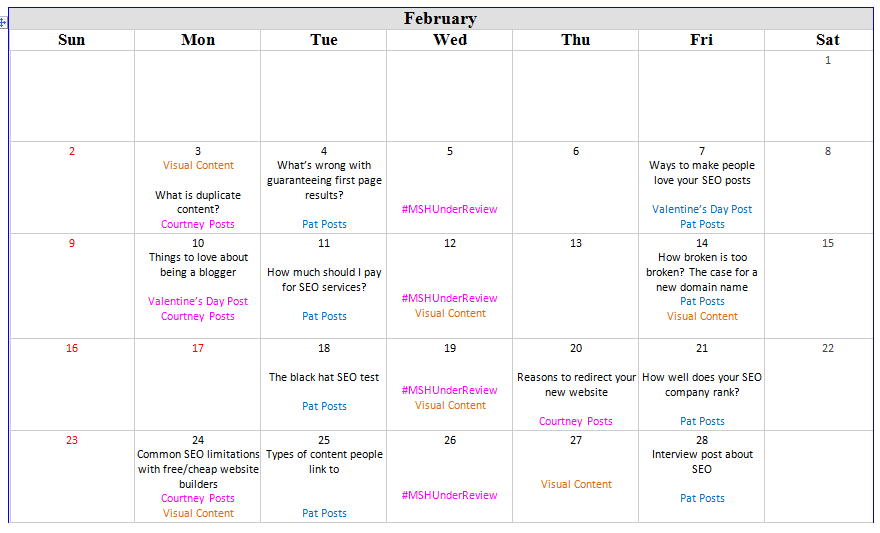At Mainstreethost, we talk endlessly about content marketing, and more specifically, blogging. We know first-hand the many benefits it has for a business, and we know how difficult it can be to get started and to continue blogging.
Day in and day out, we write about marketing for small businesses in an effort to help our company grow. For Mainstreethost, blogging has been a fundamental piece in our marketing strategy. We’ve used blogging as a means of increasing brand awareness, driving traffic to our website, growing our email contact list, and providing our audience with useful information, among other things.
It’s taken some time (and a lot of hard work), but through consistent posting, tailoring our content to our audience, and sticking to a schedule (for the most part), we’ve seen first-hand the rewards of blogging for our business.
And you can too.
I know it can be a bit of a leap to jump into blogging, but trust me; it’s totally worth it.
Here are the five steps for getting started, so you don’t have an excuse for procrastinating any longer!
Step #1: Identify your Goals
Here’s the thing: if you don’t have a clear goal for blogging, chances are your efforts will go unnoticed. Having an over-reaching goal(s) for creating blog posts forces you to inject meaning into everything you’re doing.
You’re in business, but why are you in business? I assume one of the primary goals is to make money, but aren’t there other reasons you’re in business? Maybe you want to help people. Maybe you want to make life more convenient, more entertaining, more efficient, etc.
There’s a reason behind your business: everything you do works toward that goal. The same goes for blogging. Your blogging efforts need to have a goal, and every blog post should work towards achieving that goal, directly and indirectly.
When you’re identifying the goals for blogging, categorize them into macro and micro goals – primary and secondary goals, respectively.
Examples of Macro Goals for Blogging:
- Increase sales
- Increase brand awareness
- Increase traffic to website/drive traffic from blog to website pages
- Grow email subscription list
- Increase traffic to social networks
- Increase number of visitors to specific pages (service pages, about us, shopping cart, etc.)
- Increase form completions
Examples of Micro Goals for Blogging:
- Educate audience about products/services
- Increase shares and likes on social networks
- Entertain audience by providing relevant/interesting information
*Note: each business has unique goals, so macro and micro goals will vary from organization to organization.*
Step #2: Define Your Audience and Buyer Personas
I write a lot about defining your audience (and buyer personas) because it’s just such an important element of marketing. I can’t begin to express how important your audience is. At the end of the day if you’re not writing for your audience, why are you writing at all?
In a previous post, I outlined how to tailor your online messaging to your target audience, which outlines the questions you need to answer to define your target audience and buyer personas.
Download our worksheet below – it’ll get you started with Defining and Creating your Target Audience & Buyer Personas.
Step #3: Determine How Often You Can Post (And Be Realistic)
I’m sure you’ve heard the more you post, the better off you’ll be. While this was once explicitly true, I’m here to tell you that quality always trumps quantity when it comes to blogging.
If you want to post multiple times a week, it’s going to take some hard work and dedication. Blogging is time consuming, and while the benefits are plentiful, it takes time to see results.
Before you begin to post anything, compile a reserve of evergreen content. This will help ensure that you have an abundance of content on-hand to fill up your blog with Quality posts that don’t have an expiration date (like time-sensitive news and developments).
At the very least, shoot for one post per week. This will keep you in the minds of your customers without it becoming too overwhelming for you (especially if you’re the only person writing posts).
Step #4: Brainstorm Possible Post Topics and Generate Working Post Titles
Image from Juhan Sonin, licensed under CC Attribution -2.0 Generic (changes made)
Brainstorming is a great way to get ideas flowing. Take some time, sit down and flush out all the ideas you have for possible blog post topics.
Go crazy with this. It’s a just a brainstorm session – none of your ideas have to come to fruition. In fact, you might cross out more ideas than you keep, but the point is to get you brain flowing and into the writing/creative mindset.
After you have taken a significant amount of time to brainstorm, narrow down your list to topics that will resonate with your audience. This step is extremely important because you have to write for your audience, not for yourself.
Consumers are allowed to be self-centered, you’re not. When blogging, it must be all about what your audience wants, needs, craves, etc. If not, you risk losing valuable readers, sharers and brand enthusiasts.
Need Some Inspiration?
- Talk to your sales people about FAQs they receive
- Talk to your customer service department about common issues/questions they receive
- Keep up with the news
- Read industry blogs (for inspiration – don’t copy what others are doing)
- Go through your products and services to come up with possible pain points, issues and questions your customers might have with them
Once you have a list of topics, generate “working” post titles based on the wants, the needs, interests and pain points of your audience.
The post titles you come up with don’t have to be the final titles, but give yourself something to work with. You can always go back, spice it up and make the title alluring, but having a clear idea of what each post will address makes it much easier to write. You might even think about drafting rough outlines and/or specific points that you want each post to touch on.
Step #5: Create a Practical Editorial (Content and Social Media) Calendar
To help you stick to a schedule, create an editorial calendar that includes details such as:
- Post topic
- Post title
- Author (if you have more than one person writing blog posts)
- Who the post will target (think target audience and buyer personas here)
- Keyword(s) to focus on
- Draft due date
- Publish date
- The channels you will use to promote your posts
Below is an example of one part of our editorial calendar. We find that plotting out our content for each month in calendar form works best for us. We use this to map out tentative due dates/publish dates for our blog posts. As you can see, we have “working” titles assigned, as well as the author of each post.
You should also plan out and schedule your social media posts on an editorial calendar to make sure you’re getting the most out of each post.
While there are several effective ways to create an editorial calendar, my advice is to test out a few different ways to determine what works best for you. Whether you create an Excel document with all of your ideas and posting requirements, or use a Google Doc to set up publishing dates with post topics and “working” titles, figure out what works best for you and stick to it!
Going a step further with your editorial calendar, use a sharing tool that allows you to schedule multiple posts on multiple platforms from one convenient location. Check out tools like Buffer and Hootsuite, to increase your productivity and the reach of your blog posts. After all, sharing your posts on social media is one of the most time and cost effective ways to increase exposure and engagement for your blog. Just make sure each post is unique!
Now It’s Your Turn
Now that you know how to get started with blogging, it’s time to put that knowledge into action. Just take it one-step at a time, and in no time you’ll be writing and ready to hit publish.
Do you have any advice, suggestions or questions about blogging for your business? Share them in the comments below!






